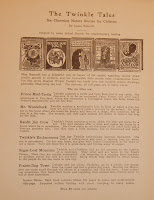
L. Frank Baum wrote The Master Key for his son Robert, to whom the book was dedicated. This tale from 1901 tells of the power of the Demon of Electricity, and the inability of mankind to make proper use of his gifts. Some of these gifts are precursors to items later found in the land of Oz, where magic is a science, after all.
Fanny Corey provided the illustrations for this book - she also illustrated Baum's The Enchanted Island of Yew. I'm not aware of any artwork surviving from this title.
 I've always liked the later binding state of this book. This was produced after the publisher Bowen-Merrill changed their name to Bobbs-Merrill. The title page still reads Bowen Merrill, but the new name of the firm is on the spine. The gilt stamping of the title and author has been dropped, but I think the yellow binding makes the book look more cheerful - the original olive drab is a bit - drab.
I've always liked the later binding state of this book. This was produced after the publisher Bowen-Merrill changed their name to Bobbs-Merrill. The title page still reads Bowen Merrill, but the new name of the firm is on the spine. The gilt stamping of the title and author has been dropped, but I think the yellow binding makes the book look more cheerful - the original olive drab is a bit - drab.Although Bobbs Merrill kept most of Baum's early titles available into the 1920's, this title seems to have been dropped from the lineup - I don't know why.


















































